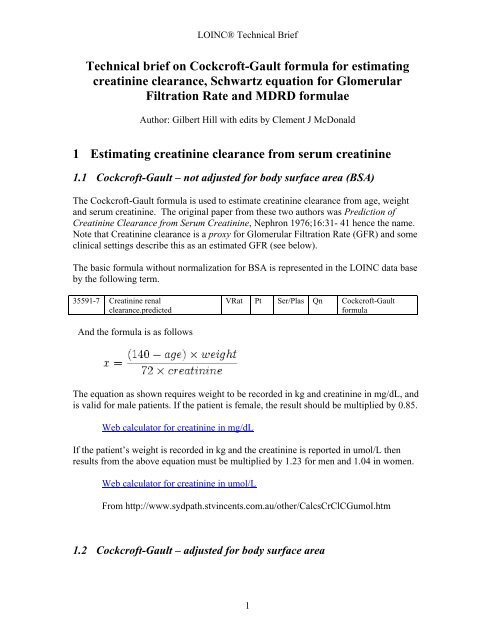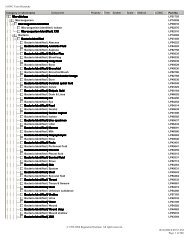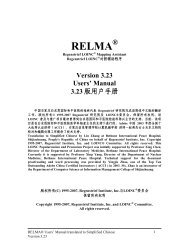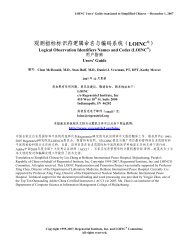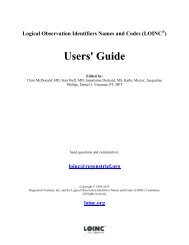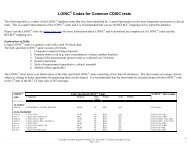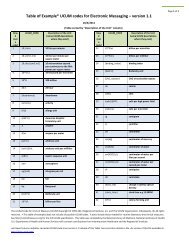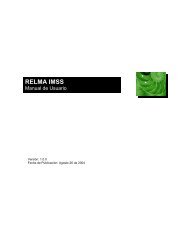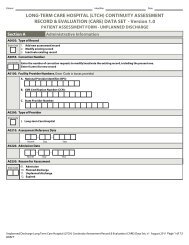Technical brief on Cockroft-Gault Formula for estimating ... - LOINC
Technical brief on Cockroft-Gault Formula for estimating ... - LOINC
Technical brief on Cockroft-Gault Formula for estimating ... - LOINC
Create successful ePaper yourself
Turn your PDF publications into a flip-book with our unique Google optimized e-Paper software.
<strong>LOINC</strong>® <str<strong>on</strong>g>Technical</str<strong>on</strong>g> Brief<br />
<str<strong>on</strong>g>Technical</str<strong>on</strong>g> <str<strong>on</strong>g>brief</str<strong>on</strong>g> <strong>on</strong> Cockcroft-<strong>Gault</strong> <strong>for</strong>mula <strong>for</strong> <strong>estimating</strong><br />
creatinine clearance, Schwartz equati<strong>on</strong> <strong>for</strong> Glomerular<br />
Filtrati<strong>on</strong> Rate and MDRD <strong>for</strong>mulae<br />
Author: Gilbert Hill with edits by Clement J McD<strong>on</strong>ald<br />
1 Estimating creatinine clearance from serum creatinine<br />
1.1 Cockcroft-<strong>Gault</strong> – not adjusted <strong>for</strong> body surface area (BSA)<br />
The Cockcroft-<strong>Gault</strong> <strong>for</strong>mula is used to estimate creatinine clearance from age, weight<br />
and serum creatinine. The original paper from these two authors was Predicti<strong>on</strong> of<br />
Creatinine Clearance from Serum Creatinine, Nephr<strong>on</strong> 1976;16:31- 41 hence the name.<br />
Note that Creatinine clearance is a proxy <strong>for</strong> Glomerular Filtrati<strong>on</strong> Rate (GFR) and some<br />
clinical settings describe this as an estimated GFR (see below).<br />
The basic <strong>for</strong>mula without normalizati<strong>on</strong> <strong>for</strong> BSA is represented in the <strong>LOINC</strong> data base<br />
by the following term.<br />
35591-7 Creatinine renal<br />
clearance.predicted<br />
And the <strong>for</strong>mula is as follows<br />
VRat Pt Ser/Plas Qn Cockcroft-<strong>Gault</strong><br />
<strong>for</strong>mula<br />
The equati<strong>on</strong> as shown requires weight to be recorded in kg and creatinine in mg/dL, and<br />
is valid <strong>for</strong> male patients. If the patient is female, the result should be multiplied by 0.85.<br />
Web calculator <strong>for</strong> creatinine in mg/dL<br />
If the patient’s weight is recorded in kg and the creatinine is reported in umol/L then<br />
results from the above equati<strong>on</strong> must be multiplied by 1.23 <strong>for</strong> men and 1.04 in women.<br />
Web calculator <strong>for</strong> creatinine in umol/L<br />
From http://www.sydpath.stvincents.com.au/other/CalcsCrClCGumol.htm<br />
1.2 Cockcroft-<strong>Gault</strong> – adjusted <strong>for</strong> body surface area<br />
1
<strong>LOINC</strong>® <str<strong>on</strong>g>Technical</str<strong>on</strong>g> Brief<br />
It is now comm<strong>on</strong> practice <strong>for</strong> the creatinine clearance calculated by the Cockcroft-<strong>Gault</strong><br />
<strong>for</strong>mula to be normalized <strong>for</strong> a body surface area of 1.73 m 2 .<br />
In particular, the Cockcroft-<strong>Gault</strong> BSA adjusted <strong>for</strong>mula is used by many pharmacy<br />
departments <strong>for</strong> medicati<strong>on</strong> dosage adjustments.<br />
<strong>LOINC</strong> terms <strong>for</strong> BSA adjusted creatinine clearance<br />
35592-5 Creatinine renal clearance/1.73<br />
sq M.predicted<br />
50380-5 Creatinine renal clearance/1.73<br />
sq M.predicted.female<br />
50381-3 Creatinine renal clearance/1.73<br />
sq M.predicted.male<br />
2 Direct predicti<strong>on</strong> of GFR<br />
2.1 Creatinine-based predicti<strong>on</strong> of GFR<br />
VRat Pt Ser/Plas Qn Cockcroft-<strong>Gault</strong><br />
<strong>for</strong>mula, corrected<br />
2<br />
<strong>for</strong> BSA<br />
VRat 24H Ser/Plas Qn Cockcroft-<strong>Gault</strong><br />
<strong>for</strong>mula, corrected<br />
<strong>for</strong> BSA<br />
VRat 24H Ser/Plas Qn Cockcroft-<strong>Gault</strong><br />
<strong>for</strong>mula, corrected<br />
<strong>for</strong> BSA<br />
2.1.1 Schwartz <strong>for</strong>mula <strong>for</strong> Pediatrics<br />
The Schwartz <strong>for</strong>mula is used to predict GFR in pediatrics. The original paper by G F<br />
Schwartz et al, is A Simple Estimate of GFR in Children Using Body Length and Plasma<br />
Creatinine, Pediatrics 1976;58:259-263 has become more relevant in the last few years<br />
because the MDRD <strong>for</strong>mula (below) is specifically stated NOT to be applicable to<br />
patients under 18 years of age. The Schwartz <strong>for</strong>mula depends <strong>on</strong> age, gender, and body<br />
height and serum creatinine. The equati<strong>on</strong> can be stated as follows:<br />
GFR Calculator <strong>for</strong> Children<br />
Schwartz <strong>Formula</strong><br />
GFR (mL/min/1.73 m 2 ) = k (Height) / Serum Creatinine<br />
k = C<strong>on</strong>stant<br />
o k = 0.33 in Preemie Infants<br />
o k = 0.45 in Term infants to 1 year old<br />
o k = 0.55 in Children to 13 years<br />
o k = 0.65 in Adolescent males (Not females because of the presumed<br />
increase in male muscle mass. The c<strong>on</strong>stant remains .55 <strong>for</strong> females.)<br />
Height in cm<br />
Serum Creatinine in mg/dl<br />
Web calculator <strong>for</strong> Schwartz <strong>Formula</strong>
<strong>LOINC</strong> term <strong>for</strong> Schwartz <strong>for</strong>mula<br />
50384-7 Glomerular filtrati<strong>on</strong> rate/1.73 sq<br />
M.predicted<br />
<strong>LOINC</strong>® <str<strong>on</strong>g>Technical</str<strong>on</strong>g> Brief<br />
VRat 24H Ser/Plas Qn Creatinine-based<br />
<strong>for</strong>mula (Schwartz)<br />
2.1.2 MDRD 4 variables<br />
The MDRD 4 variable equati<strong>on</strong> is the principle equati<strong>on</strong> recommended by professi<strong>on</strong>al<br />
nephrology societies to estimate the GFR. It depends up<strong>on</strong> serum creatinine, age, gender<br />
and race. It also includes a BSA adjustment term of 1.73 - the average body surface area<br />
in an adult male. (Equati<strong>on</strong>s incorporating height and weight can be used to correct this<br />
equati<strong>on</strong> when patients are far from the mean in BSA- but are not routinely used.<br />
The following is (taken from NKF MDR web site )<br />
The Nati<strong>on</strong>al Kidney Disease Educati<strong>on</strong> Program (NKDEP) of the Nati<strong>on</strong>al<br />
Institute of Diabetes and Diseases of the Kidney (NIDDK), Nati<strong>on</strong>al Kidney<br />
Foundati<strong>on</strong> (NKF) and American Society of Nephrology (ASN) recommend<br />
<strong>estimating</strong> GFR from serum creatinine using the MDRD Study equati<strong>on</strong>. This<br />
equati<strong>on</strong> depends up<strong>on</strong> the serum creatinine age, gender and race to estimate the<br />
GFR and there<strong>for</strong>e improves up<strong>on</strong> several of the limitati<strong>on</strong>s with the use of serum<br />
creatinine al<strong>on</strong>e. The MDRD Study equati<strong>on</strong> has been rigorously developed and<br />
validated, and is more accurate than measured creatinine clearance from 24-hour<br />
urine collecti<strong>on</strong>s. The equati<strong>on</strong> is:<br />
GFR = 186 x (PCr) -1.154 x (age) -0.203 x (0.742 if female) x (1.210 if black)<br />
GFR is expressed in ml/min/1.73 m 2. , In this equati<strong>on</strong> Pcr serum creatinine must<br />
be expressed in mg/dl, and age in years. (Of course other units can be used if the<br />
right side of the above equati<strong>on</strong> is multiplied by the appropriate c<strong>on</strong>stant). (all<br />
taken from NKF web site - http://www.kidney.org/professi<strong>on</strong>als/KLS/gfr.cfm#2<br />
December 04 2006)<br />
Web calculator <strong>for</strong> MDRD<br />
The glomerular filtrati<strong>on</strong> rate predicted by the MDRD <strong>for</strong>mula may be reported in at least<br />
3 ways:<br />
a) All four variables are known and used in the equati<strong>on</strong>. The result would be race and<br />
gender adjusted creatinine clearance.<br />
b) Only two variables (serum creatinine and age) are used in the equati<strong>on</strong>. In this<br />
circumstance, the report may:<br />
i) include a comment saying – “if patient is black multiple result by 1.21” and/or<br />
“if patient is female multiply the result by .742”<br />
or ii) may include two values: N1 if white and N2 if black, and a correcti<strong>on</strong> factor <strong>for</strong><br />
gender: if patient is female multiply the result by .742 .<br />
3
<strong>LOINC</strong> codes <strong>for</strong> MDRD <strong>for</strong>mula<br />
33914-3 Glomerular filtrati<strong>on</strong> rate/1.73 sq<br />
M.predicted<br />
48642-3 Glomerular filtrati<strong>on</strong> rate/1.73 sq<br />
M.predicted.n<strong>on</strong> black<br />
48643-1 Glomerular filtrati<strong>on</strong> rate/1.73 sq<br />
M.predicted.black<br />
50044-7 Glomerular filtrati<strong>on</strong> rate/1.73.<br />
sq M.predicted.female<br />
<strong>LOINC</strong>® <str<strong>on</strong>g>Technical</str<strong>on</strong>g> Brief<br />
VRat Pt Ser/Plas Qn Creatinine-based<br />
<strong>for</strong>mula (MDRD)<br />
VRat Pt Ser/Plas Qn Creatinine-based<br />
<strong>for</strong>mula (MDRD)<br />
VRat Pt Ser/Plas Qn Creatinine-based<br />
<strong>for</strong>mula (MDRD)<br />
VRat Pt Ser/Plas Qn Creatinine-based<br />
<strong>for</strong>mula (MDRD)<br />
2.1.3 MDRD 6 variables<br />
A six variable versi<strong>on</strong> of the MDRD exists. This <strong>on</strong>e depends <strong>on</strong> the patient’s serum<br />
albumin and serum urea nitrogen values in additi<strong>on</strong> to the MDRD-4 variables, but is not<br />
the preferred equati<strong>on</strong> <strong>for</strong> this estimate.<br />
Where PCr=serum creatinine c<strong>on</strong>centrati<strong>on</strong> (mg/dl) (alkaline picrate method);<br />
SUN=serum urea nitrogen c<strong>on</strong>centrati<strong>on</strong> (mg/dl) (urease method); Alb=serum albumin<br />
c<strong>on</strong>centrati<strong>on</strong> (g/dl) (bromocresol green method).<br />
Taken from:<br />
Stoves J,Lindley E,Barnfield M,Burnist<strong>on</strong> T, Newstead C. MDRD equati<strong>on</strong> estimates of<br />
glomerular filtrati<strong>on</strong> rate in potential living kidney d<strong>on</strong>ors and renal transplant recipients<br />
with impaired graft functi<strong>on</strong>.Nephrol Dial Transplant.2002,17: 2036-2037<br />
2.2 Cystatin-based predicti<strong>on</strong> of GFR<br />
Although the MDRD equati<strong>on</strong>, based <strong>on</strong> the measurement of serum creatinine, is the<br />
most widely used method <strong>for</strong> <strong>estimating</strong> GFR, an alternative, based <strong>on</strong> the measurement<br />
of serum cystatin is claimed to have certain advantages.<br />
Estimating Glomerular Filtrati<strong>on</strong> Rate in Kidney Transplantati<strong>on</strong>: A Comparis<strong>on</strong><br />
between Serum Creatinine and Cystatin C-Based Methods, J Am Soc Nephrol 16: 3763–<br />
3770, 2005<br />
Web calculator <strong>for</strong> Cystatin-based GFR<br />
<strong>LOINC</strong> code <strong>for</strong> GFR predicted by a cystatin-based <strong>for</strong>mula<br />
50210-4 Glomerular filtrati<strong>on</strong> rate/1.73 sq<br />
M.predicted<br />
VRat Pt Ser/Plas Qn Cystatin-based<br />
<strong>for</strong>mula<br />
4


